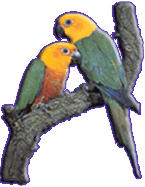|
|
| |
|
|
|
|
MASKED LOVEBIRD
Agapornis Personata |
|
|
As well as Ficher's lovebird, ornithologist Reichenow first described them, in 1887.
Masked lovebirds or Personata initially come from Africa , as all their relatives from the genus “Agapornis”. They are mostly native in Kenya and central Tanzania . Their size is around 14,5cm, and basic color is green. Forehead, cheeks and pate are black with a little bit of brown nape is olive-brown and orange red, and on the neck they have yellow ring. Rump and great wing coverts are light blue. Wings are 9,5cm, upper wings feathers are orange and at the end are black. Eyes are brown, and around the eyes, they have featherless white rings. Beak is colored in coral red and 2 cm sized. Legs are grey. Female has paled colors and it is a bit bigger than male. Off course, as they belong to genus “Agapornis”, the sex is very difficult to estimate, even by the size of pelvic. Natural habitat of masked lovebirds is at 1100 to 1800m altitude. They make nests on acacia trees as well as in bushy growing of steppe and open grassland.
The population of masked lovebirds is in danger because of large export. There is belief that just 50000 of masked lovebirds are left in nature. They live in flocks with 20 to 80 birds when it's not the mating period. They are gathering in cultivate areas for easier and better feeding. When migrating they make loud noises, but for people it is quite nice song. Mating time is during dry period in March and April until June, sometimes even till August. They make nests in hollows of baobab trees or some other trees. Nests are made of twigs in shape of labyrinth with two gaps. On the bottom, in the cutting, female hatch 3 to 6 eggs size 23x17mm. Their menu, in wild, consists of various seed, berries, buds and fruit. |
Masked lovebirds in period of mating,
green (normal) masked lovebird
–on the left,
in the middle two blue masked lovebirds,
on the right -silver masked lovebird |
|
|
|
|
normal
and
blue masked lovebird
(left to right)
|
|
| |
pair of blue masked lovebirds
|
| In volier or house conditions, their menu consists of proso, oats, bright seed, canary seed, sorghum and bar millet with a bit of fruit and vegetables , as well as minerals and complex of vitamins. Fruits they should not eat are pear, peach, melon and watermelon because of possible diarrhea. Vegetables they should not eat are lettuce, cabbage and all sorts of cabbage family vegetables (kale, cauliflower...). Safe fresh food consists of dandelion leaf, chickweed, spinach or parsley sprig. Vegetables safe for them to eat carrot, cucumber and parsley of a sweet paprika with the seed. From time to time, it would be good to give them soft food, especially to the young birds, and that is a mix of hard boiled eggs, crackers and a bit of the blue poppy.
|
|
|
Like with most of parrot species breeders made various mutations of masked lovebirds. Beside normal masked lovebird with green color base, there are blue, pale yellow, lutino, dark green and olive green masked lovebirds. However, there are combinations of mutations: blue-white (white meaning pale yellow and blue), albino (lutino and blue), cobalt (blue and dark green), mauva (blue with olive green). Special mutations and modifications are multicolored, cinnamon, falb, orange-red, red-beaked with basic blue, partial colored, Danish yellow, pale blue, grey-winged and violet colored.
Masked lovebirds don't have subspecies. |
|
Ficher's lovebird (in the left) with masked lovebirds (silver, blue and normal)
|
|
|
|
silver masked lovebird feeding young |
normal (green) masked lovebirds and one ficher's lovebird |
|
As pets they have to be in pair. They need roomy cage, good food and baths or cups for bath, because they really enjoy in water. Their voice is very nice and you will enjoy in their singing. If you get pair of these, soon they will become your favorite mates. |
|
|
|
|
| Quality certificate
|
|
|
| |
|
|
|
|

